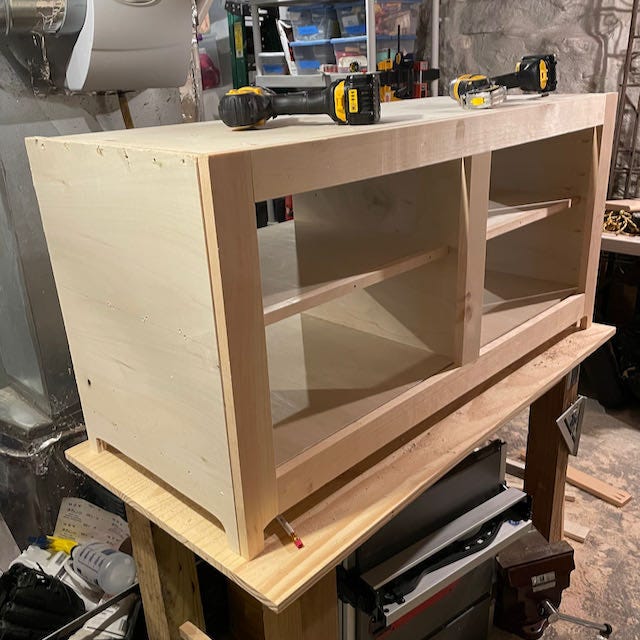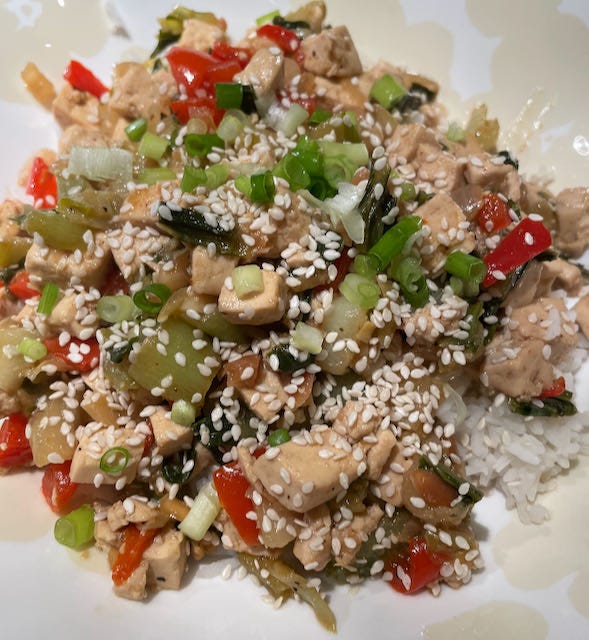Welcome to the Quarantine Creatives newsletter, a companion to my podcast of the same name.
As I noted in the newsletter and on the show last month, I wanted to take a little time off from the podcast to both catch my breath after a breakneck pace of shows and to consider what the future looks like. New episodes will return soon, however in the meantime, I wanted to share some of my recent reflections with you with the hope that they may inspire you or help you in your own journey.
Thinking About Creativity
If you follow me on Instagram or Twitter, then you may have seen the new piece of furniture that I have been building. This will eventually be a storage cabinet for our living room that will hold board games and other kids’ toys. It’s the first big project that I’ve tackled in my basement since converting it to a really bare bones shop over Christmas.
Woodworking is a relatively new hobby for me, which is surprising for many given my long association with This Old House. I have built a handful of projects over the last five years or so and really enjoy the problem solving that comes from designing and building simple, functional furniture. It allows me to express the same creative spirit that I usually bring to media projects like TV or podcasting, but it also uses other parts of my brain and my body, which I really enjoy.
This particular build has gone very smoothly, and I think a large part of the reason is the amount of planning that went into it. This cabinet started as an idea in my head that I let slosh around for a few days. After having a clear picture in my head, I sat down and created a few sketches. I returned to those sketches every few days, thinking through how I wanted to cut each piece of wood, where my fasteners would go, etc, each time adding a new level of detail or a note to myself.
There have still been a few problems to solve once I started building, mostly because I knew it would be easier to visualize once other parts had been built than to try to guess on paper, but overall, this project is going quickly and with very few mistakes. Since I still consider myself a novice woodworker, that’s a victory in my book.
I have been giving a lot of thought lately to the power of visualization and the importance of planning. My wife recently introduced me to the work of Jay Shetty. He is an author and podcaster who spent a few years living and training as a monk in India and has taken many of the principles he learned during that time and turned them into a best selling book that came out last year, Think Like a Monk.
As I read Jay’s book, I have been thinking about how many of the ideas he discusses about leading a fulfilling life are also techniques that lead to a successful producer. I know a monk and a producer feel like opposite worlds, but I’ll get to some of his ideas a little later on. But just like in building my cabinet this week, it comes down to mindset and mindfulness.
Beat Sheets on Set
I have found that my most creative moments happen when I can stop focusing on the mundane details of a project and can instead consider the bigger picture and think more conceptually about it. Sometimes just asking the point or goal of something can lead you to realize that you’re trying to solve the wrong problem.
This does not mean that the mundane details are not a priority or that they can be ignored. Quite the contrary. But I have found that by solving those smaller problems in advance and as removed from the time of creation as possible, it frees your mind up for truly creative decisions in the moment and to always focus on that bigger picture. In the case of building furniture, that meant considering where each screw goes long before I even bought lumber.
On an unscripted reality show like Ask This Old House, where you never know exactly what will happen when you open up a wall for example, we used beat sheets as one of our most important tools. They are basic outlines of the segment that usually ranged from two to four pages and are common in this style of production.
A beat sheet was written (and then rewritten and rewritten) two or more weeks before a shoot, and the goal was to make as many small decisions as possible from the quiet comfort of an office. This allowed me time to consider the story points, casting, and general flow of the story. Beat sheets also accounted for specialty equipment that might be needed (cameras, lighting, audio, etc), and any additional assets that needed to be captured like specific stills or tease lines for social media and broadcast. The beat sheet was then published and shared with all members of the team, including not just the production crew but even teams like sales and marketing, social media, and post production.
By making a majority of my decisions days or weeks in advance, I always felt grounded on a shoot day, knowing that I had a plan and we were executing that plan. But it also allowed for more improvisation and spontaneity. By knowing what the “rules” of a segment were, it freed all of us to think less about small decisions and to see opportunities that would have been hard to see if we were focusing on minutiae. If the day was running long, it also allowed us to know where we could speed things along or skimp on coverage, because we always knew the relative weighting of each scene and its importance to the final edit.
Beat Sheets in Life
If you were to apply some of these same principles to your life, what would be your version of a beat sheet and which decisions would you offload from a stressful time to a time when you can make clearer decisions?
One idea that my family recently adopted is meal planning. This is something that I learned from my brother-in-law and sister. He runs a financial planning business geared towards helping teachers control their money called The Budget Teacher (he also hosts a podcast of the same name).
For their family, meal planning is a way to save money. We were inspired by them and started a meal plan in our family, although we use it more as a means to be better organized and to limit our food waste.
For the past couple of weeks, my wife and I have sat down on the weekend and planned out lunch and dinner for every day the following week. We account for what food we have on hand and then also make a grocery list based on our planned menu. We print out the meal plan and post it in the kitchen so that the whole family knows what to expect.
I have found that since we started doing this, meal times have been much more organized and we have been more thoughtful about our meals too, incorporating more fish and vegetarian dishes and less processed foods, which are easy to make but can be unhealthy. It also has decreased stress and allowed us to spend more of our weekdays focused on other priorities, knowing that dinner has already been decided.
Much like beat sheets, a meal plan is simply a plan and is not set in stone. There have been days where we have decided we don’t want to cook as elaborate a meal as we had planned, or there are still leftovers that we’d rather eat instead. Varying the meal plan is not a problem, but knowing that we have a plan has been a really positive, small step.
In Jay Shetty’s book that I referenced above, another idea that really stood out to me that is relevant to this discussion is the importance of having a “uniform.” Monks all wear bright colored robes and shave their heads in part so that they aren’t thinking too strongly about their outward appearance, but it is also a uniform. When you think of successful people like Steve Jobs and Mark Zuckerberg, they have adopted this principle.
Like a beat sheet, having a “look” that you are comfortable in and is practical for your daily life offloads a bunch of decision making that can be stressful, especially when it’s decided first thing in the morning while you are trying to get breakfast ready and kids off to school.
While Jay provided this advice in his book, I have been wearing a uniform of sorts for close to a decade now without even fully realizing it. Everyday, most of my outfit is really consistent. I have chosen clothes that are comfortable for me, durable, and fit any number of scenarios, from a soundstage to a construction site to a conference room. The basics are always the same: a good pair of jeans (I buy multiples at a time in the same style), Cowboy boots that provide support and comfort, don’t need lacing, and can stand up to anything unexpected. I also buy essentials like undershirts and socks in bulk from Costco and only have one style, although in multiples. This makes matching socks really easy when folding laundry, by the way.
Where my daily creativity comes in with wardrobe is in my tops, but even then, I have a formula. Once I find a style that I like, I tend to buy several versions of the same shirt in other colors or patterns. This allows me just enough daily variety to not get bored, yet enough predictability to make dressing easy. I also select my clothes for the next day the night before.
While making decisions about mundane daily obligations like dressing and eating in advance may seem excessive, I have found that making the time to set up these systems allows for greater time for free thought, creativity, and other activities during the day. Just like it’s important to show up to set prepared and have the small decisions taken care of in advance, the same goes for how you live your life. I know a lot of rockstar producers that lose that drive in their personal lives, but I’m here to tell you that if you start producing life the way you produce a show, it can actually lead to more personal time and less stress, as counterintuitive as that may sound at first.
I hope you’ve found this issue of the newsletter helpful, even though it was a little different from past issues. Please let me know if you’d like to see more discussions like this going forward or if there are other thoughts or ideas you’d like to share!
If you have questions, comments, thoughts, ideas, or anything else that you’d like to share, please feel free to email me anytime: hracela@mac.com
If you’re an Apple Podcasts user, please consider leaving a rating or review for Quarantine Creatives. It only takes a minute, but it helps bring in new listeners.
And please consider sharing this with a friend that you think might enjoy reading this, or better yet, share it on social media so you can tell hundreds of friends!
If you’ve missed past issues of this newsletter, they are available to read here.







